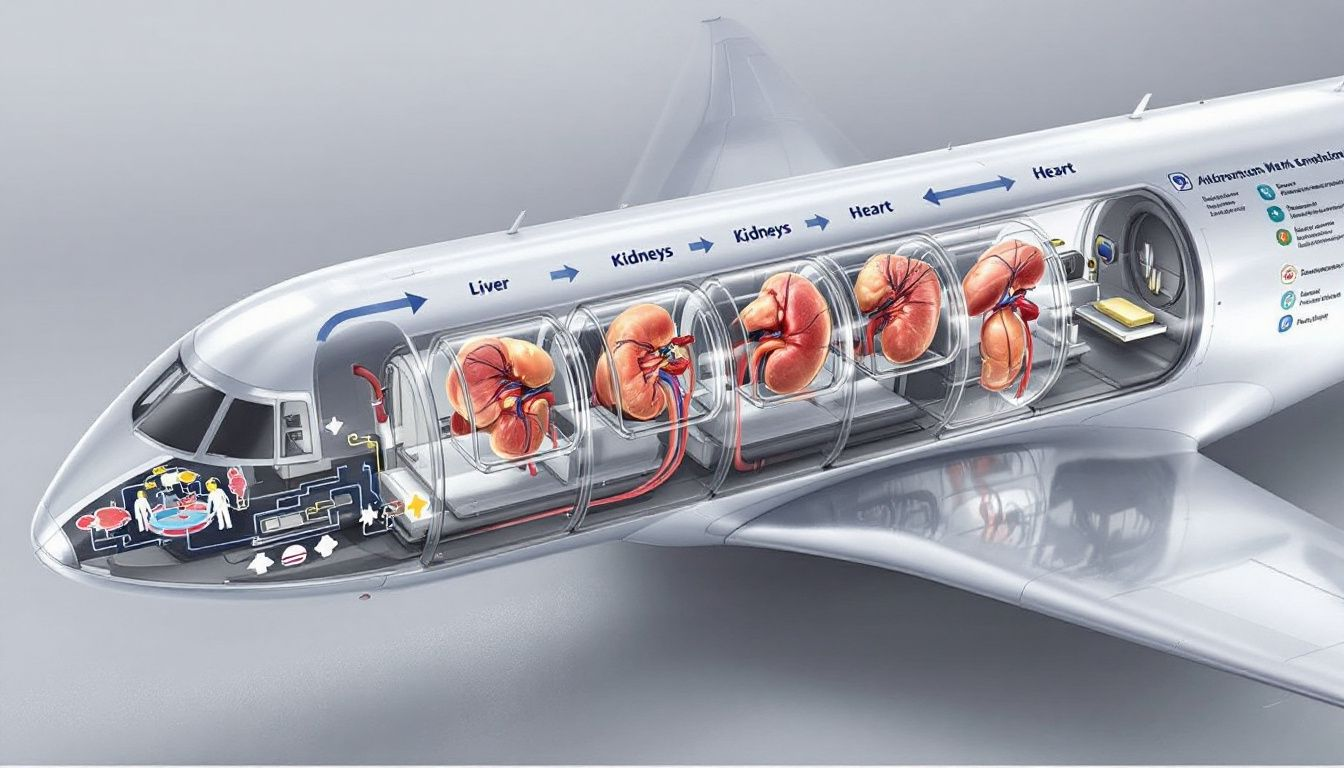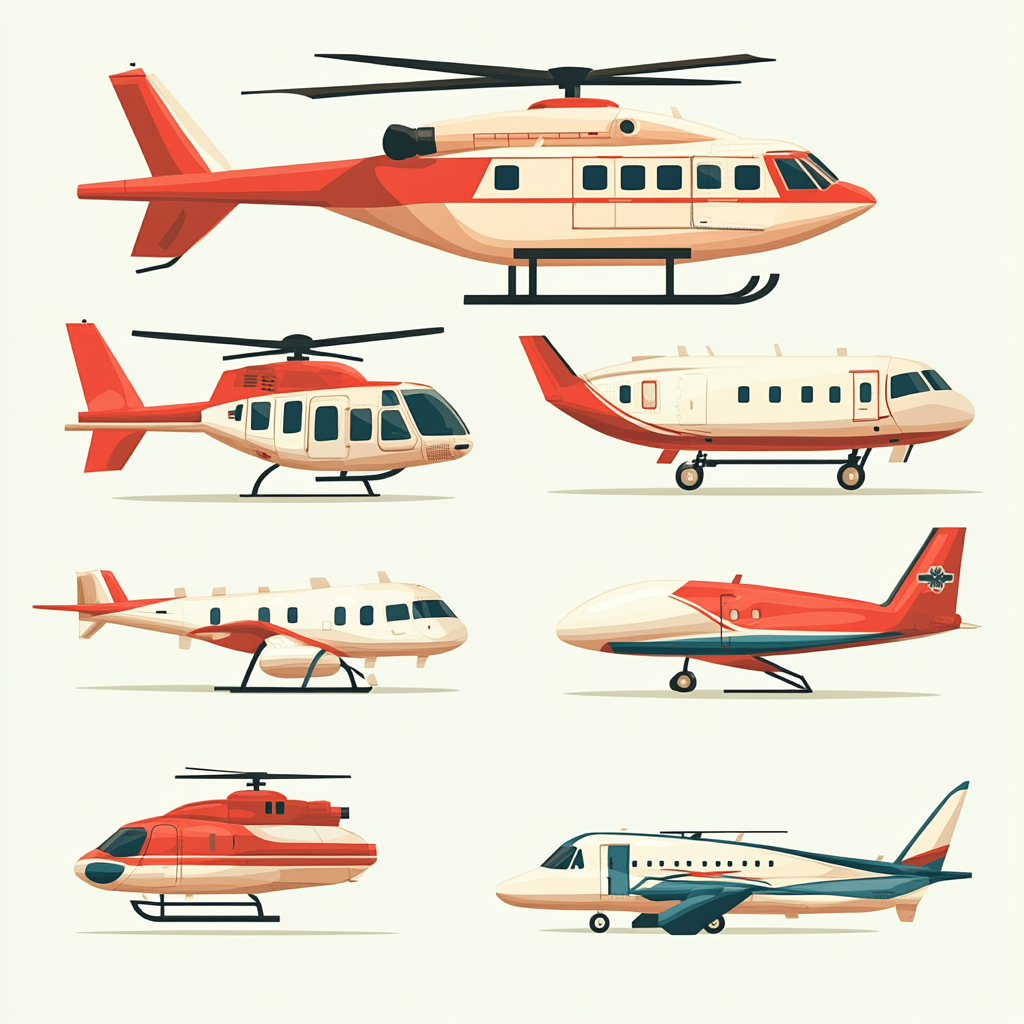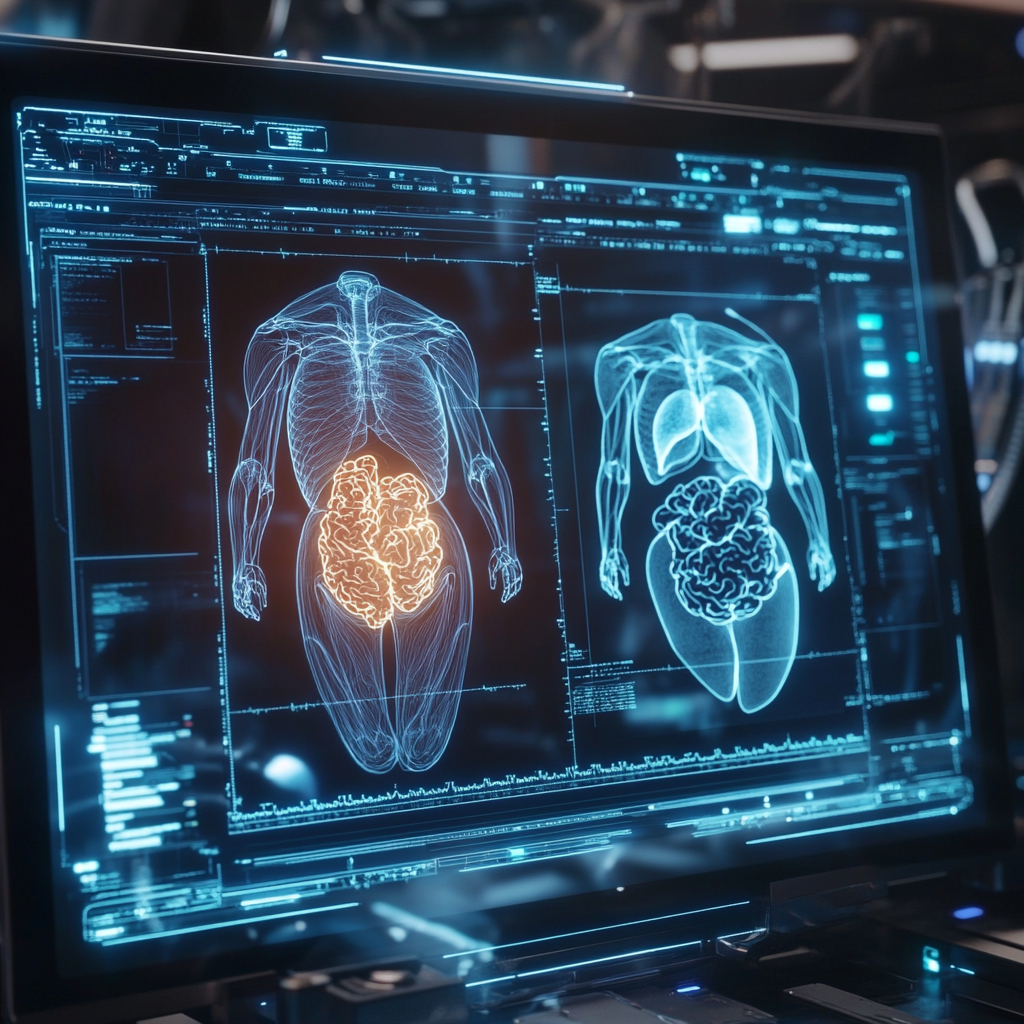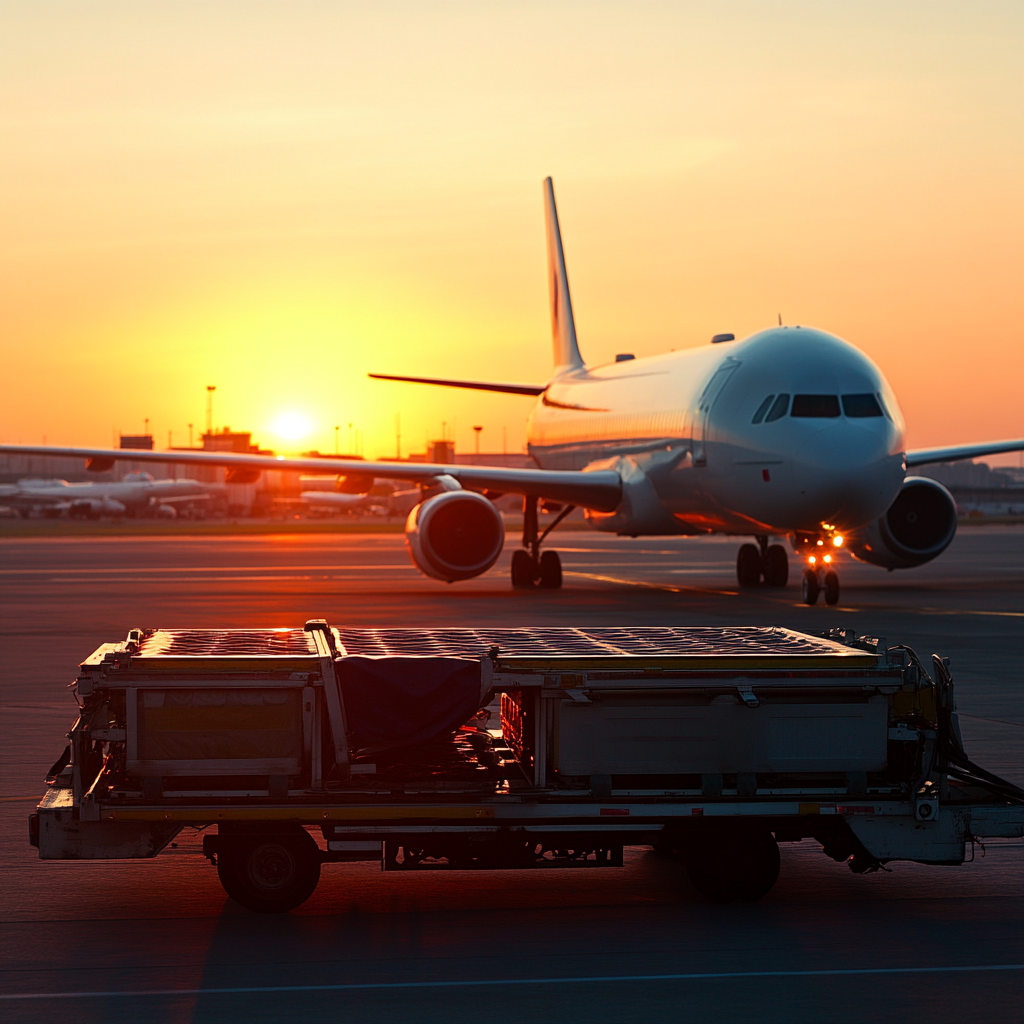How Organs Are Transported by Air: Saving Lives in Flight
Organs have tight viability windows, making air transport essential for timely transplants. This article explores how organs are transported by air, including the methods, technologies, and logistics involved, ensuring they reach recipients swiftly and safely.
Key Takeaways
Air transport is essential for organ transplantation, significantly reducing transport time and improving viability, especially for critical organs like hearts and livers.
Different aircraft types, including helicopters and jets, are utilized based on distance and urgency, with specialized aircraft equipped to maintain optimal conditions for organ preservation during transit.
Advancements in technology, such as real-time tracking systems and potential drone delivery, are enhancing the efficiency and reliability of organ transport, ultimately improving patient outcomes.
The Critical Role of Air Transport in Organ Transplantation

Transplanting organs for transplant is extremely urgent. Hearts, for instance, need to be transplanted within four hours of being harvested to stay viable. This limited window highlights the essential role of air transport in organ transplantation. Moving organs from donor to recipient typically takes 6 to 10 hours, making quick transportation solutions critical. Many life-saving procedures rely on the swift capabilities of air transport.
Air transport is crucial for both domestic and international organ transfers. This is particularly important for patients with rare blood types or children on waiting lists, increasing the availability of suitable organs. The unpredictable nature of organ donation requires readiness and rapid response, with innovative aerial solutions continuously improving the efficiency of these critical missions.
Methods of Air Transport for Organs

Transporting organs involves different methods based on distance and urgency. Helicopters are ideal for short distances, able to land directly at hospitals and navigate congested or remote areas.
Jets are preferred for longer distances due to their speed and ability to cover vast areas without stops. Specialized aircraft with advanced preservation technology ensure the viability of organs during transit.
Helicopters for Short-Distance Transport
Helicopters serve as a lifeline for short-distance organ transport, bridging the gap between donor and recipient quickly. A key advantage of helicopters is their ability to land directly at hospitals, reducing transport time significantly. This is especially beneficial in urban areas with heavy traffic or remote locations where other transport methods are impractical. Helicopters can typically cover distances up to 200 miles, keeping organs within their critical viability windows.
Organizations like Alpine Air Ambulance operate helicopter fleets, offering rapid transport solutions for organ procurement. These specialized aircraft handle the delicate nature of human organs, ensuring safe and efficient transport to their destination.
Jets for Long-Distance Transport
Jets are preferred for long-distance organ transport due to their speed and nonstop travel capabilities. This is crucial for transporting organs like hearts and livers, where every minute counts. Jets can cover large areas quickly, ensuring organs arrive swiftly and in optimal condition, vital for successful transplantation.
Jets have revolutionized long-distance organ transport, making it possible to save lives across continents. High speed and nonstop travel reduce the risk of delays, ensuring organs remain viable during transit.
Specialized Aircraft for Organ Transportation
Specialized aircraft for organ transport come equipped with advanced preservation technology to maintain organ viability during flight. These aircraft often feature climate control systems to regulate temperature and humidity, which are essential for preserving organ health. The interiors are customizable to accommodate different organ types and their specific requirements, ensuring optimal transport conditions.
Enhanced storage solutions securely hold organ containers, minimizing movement and shock during flight. Integrated communication systems ensure constant contact with medical teams, providing real-time updates on the organ’s status. These special solutions are crucial for ensuring organs reach their transplant centers in optimal condition.
Did you know that you can get from Manhattan to JFK in under 5 minutes without driving?
Blade offers seamless helicopter transfers from our West 30th Street Lounge in Manhattan to JFK Airport in just 5 minutes from $195 per seat.
Skip the traffic and ditch the stress with Blade's year-round airport service.

Ensuring Timely and Safe Organ Transport
Timely and safe transport is paramount for reducing cold ischemia time, critical for preserving organ viability. Efficient air transport, combined with organ preservation techniques during transport, can drastically improve organ quality for transplantation, enhancing patient outcomes.
Different aircraft types, including helicopters and jets, are chosen based on distance, urgency, and the specific organ. Collaboration among organ procurement organizations and transplant centers ensures timely and safe transfers.
Coordination with Medical Teams
Strong coordination with medical teams is crucial for successful organ transport. Implementing best practices and effective communication among all personnel can significantly reduce the risk of organ loss and ensure timely delivery. Organizations like Survival Flight work closely with organ procurement departments to determine the most effective transportation mode based on specific needs.
Complex multi-organ transport missions demand meticulous planning and execution. These missions often involve coordinating schedules between surgical teams, transport personnel, and air carriers for the simultaneous delivery of multiple organs. Providers like Kalitta Charters and AirMed offer round-the-clock availability for immediate organ transport, highlighting the importance of seamless coordination.
Proper Storage and Preservation
Proper storage and preservation during transport are critical for maintaining organ viability. Specialized aircraft with temperature control systems ensure organs remain viable throughout the journey. Maintaining optimal temperatures is crucial, as specific organs have different viability windows. For instance, hearts need to be transplanted within four to six hours, while kidneys can remain viable for up to 24 hours.
Innovative transport containers enhance preservation by maintaining blood and oxygen flow, extending viability during transport. Carefully preserved real-time tracking systems provide precise location data and alerts for any condition changes, such as temperature, ensuring optimal storage and transport conditions. Timely and safe transport is paramount for reducing cold ischemia time, critical for preserving [organ viability after death (https://www.blade.com/how-long-are-organs-viable-after-death).
Compliance with Federal Aviation Administration Regulations
Compliance with Federal Aviation Administration (FAA) regulations ensures organ transport flights are conducted safely and efficiently. Adhering to these regulations minimizes transit risks and ensures flights operate under strict safety standards.
FAA regulations mandate specific rest requirements for flight crews to ensure safety during organ transport missions.
Advanced Technologies in Organ Transport

Modern technologies play a crucial role in the efficiency and timeliness of organ transport. Innovations like real-time tracking systems and condition monitoring ensure the safe transport of organs.
Future innovations like drone delivery offer promising alternatives that could enhance the speed and reliability of organ transport, reducing reliance on traditional methods.
Real-Time Tracking Systems
Real-time tracking systems revolutionize organ transport, providing continuous monitoring of the exact location and status of transported organs. These systems allow medical teams to make timely decisions, ensuring organs reach their destination within critical timeframes. They also monitor environmental conditions like temperature, ensuring organs remain viable throughout transport.
Real-time tracking enhances visibility and accountability, giving healthcare providers peace of mind that organs are transported safely and efficiently. This technology is invaluable in organ transplantation, where every second counts.
Future Innovations: Drone Delivery
The future of organ transport may lie in the skies with drones. These unmanned aerial vehicles have been successfully tested for organ transport, showing their potential to expedite hospital deliveries without the limitations of traditional aircraft. Drones can transport organs faster and with less vibration compared to traditional fixed-wing flights, improving organ quality.
As the FAA develops protocols for drone usage, the potential for these innovations to transform organ transport is immense. Drones could revolutionize organ delivery, making the process more efficient and reliable, ultimately saving more lives.
Did you know that you can get from Manhattan to JFK in under 5 minutes without driving?
Blade offers seamless helicopter transfers from our West 30th Street Lounge in Manhattan to JFK Airport in just 5 minutes from $195 per seat.
Skip the traffic and ditch the stress with Blade's year-round airport service.

Examples of Successful Air Transport Missions

Successful air transport missions for organ transplantation have significantly impacted patient outcomes. Timely air delivery of organs has been instrumental in saving lives, highlighting its critical role in organ transplantation.
Heart Transplants
Heart transplants are particularly time-sensitive, requiring rapid transport to ensure the organ remains viable. Using helicopters or jets for rapid delivery has significantly increased the chances of successful heart transplants. In one remarkable incident, a heart was successfully transplanted after retrieval from a helicopter crash site, with the patient recovering well post-surgery.
These examples underscore the importance of air transport in ensuring hearts reach transplant centers within the critical four-hour window. The speed and efficiency of air transport often decide the success of these life-saving procedures.
Kidney and Liver Transports
Air transport has proven critical in the timely delivery of kidneys and livers, often influencing transplant success rates. Numerous cases highlight the essential role of air carriers in facilitating the timely transfer of these organs, ensuring they reach recipients in optimal condition.
The ability to transport kidneys and livers quickly and efficiently has saved countless lives, demonstrating the vital role of air transport in organs transported for transplantation. Reducing transport times preserves organ viability, leading to better patient outcomes.
Multi-Organ Transports
Multi-organ transport missions are among the most complex and challenging, requiring precise coordination among medical teams and air carriers to ensure every organ reaches its destination on time without compromising viability. These missions involve aligning schedules between surgical teams, transport personnel, and air carriers to maximize efficiency in time-sensitive situations.
Challenges include managing the logistics of transporting different organ types simultaneously and ensuring proper storage and preservation during the flight. Successful multi-organ transport requires meticulous planning and execution to match strict time frames for organ viability, highlighting the advanced logistics involved in these life-saving missions.
Dependable Air Transport Providers
Dependable air transport providers play a crucial role in ensuring the timely delivery of life-saving organs for transplantation. These providers specialize in organ procurement transportation services, ensuring that organs are delivered promptly and safely. The expertise and reliability of these providers enhance the success rates of transplants, making them indispensable partners in the organ transplant process.
Leading Air Carriers
Leading air carriers like REVA and Survival Flight are at the forefront of providing efficient organ transport services. REVA operates a fleet of over a dozen aircraft, offering reliable transport for organs across various regions. Survival Flight utilizes a medically configured Cessna Citation Encore jet for long-distance organ transportation in the U.S. and Canada, showcasing the advanced capabilities of these carriers.
Kalitta Charters has a dedicated fleet and logistics management specifically for organ transport, ensuring timely and efficient deliveries. AirMed, with its fleet of medically configured aircraft, is ready for organ transports within an hour of a request, highlighting the critical role of these carriers in adhering to federal aviation administration regulations and ensuring safe and timely organ transport.
Dedicated Medical Flight Services
Dedicated medical flight services, such as those provided by GrandView Transplant, offer specialized care and customized aircraft programs tailored for hospitals. These services are available 24 hours a day, ensuring immediate dispatch of aircraft to meet urgent transportation needs.
The role of dedicated medical flight services in organ transport is crucial, providing specialized care and equipment to ensure the safe and efficient delivery of organs. These providers work closely with medical teams and hospitals to create seamless transport solutions, enhancing the overall success of organ transplant missions.
Bottom Line: How Organs Are Transported by Air: Saving Lives in Flight
In summary, the critical role of air transport in organ transplantation cannot be overstated. From helicopters and jets to specialized aircraft, each method plays a vital part in ensuring that organs reach their recipients within the critical time windows. The collaboration between medical teams, the use of advanced technologies, and the compliance with federal aviation administration regulations are key factors in the success of these life-saving missions. As we look to the future, innovations like drone delivery promise to further enhance the efficiency and reliability of organ transport, ultimately saving more lives. The dedication and expertise of dependable air transport providers continue to be the backbone of successful organ transplantation.
FAQs about How Organs Are Transported by Air
Why is air transport critical for organ transplantation?
Air transport is critical for organ transplantation because it facilitates swift delivery, which is vital given the limited viability of organs. This efficiency significantly increases the chances of successful transplantation.
What types of aircraft are used for organ transport?
Helicopters, jets, and specialized aircraft are utilized for organ transport, selected according to distance, urgency, and the specific needs of the organ.
How does proper storage and preservation impact organ transport?
Proper storage and preservation are essential for maintaining optimal temperatures and using innovative transport containers, which ensure organ viability during transport. This directly contributes to the success of transplantation procedures.
What role do real-time tracking systems play in organ transport?
Real-time tracking systems are crucial in organ transport as they monitor location and environmental conditions, ensuring the organs remain viable and safe during transit. This enhances both safety and efficiency in the transplant process.
Who are some leading providers of air transport services for organs?
REVA, Survival Flight, Kalitta Charters, AirMed, and GrandView Transplant are prominent providers known for their expertise in the timely and safe transport of organs. These organizations play a crucial role in facilitating urgent medical needs.
Disclaimer:
Please be aware that the content on this page has been generated by using artificial intelligence language models and may contain errors, inconsistencies, or outdated information. It is provided as-is without any warranties or guarantees of accuracy. We strongly recommend using this content as a starting point for further research. We disclaim any liability for damages or losses resulting from the use or reliance on this content.